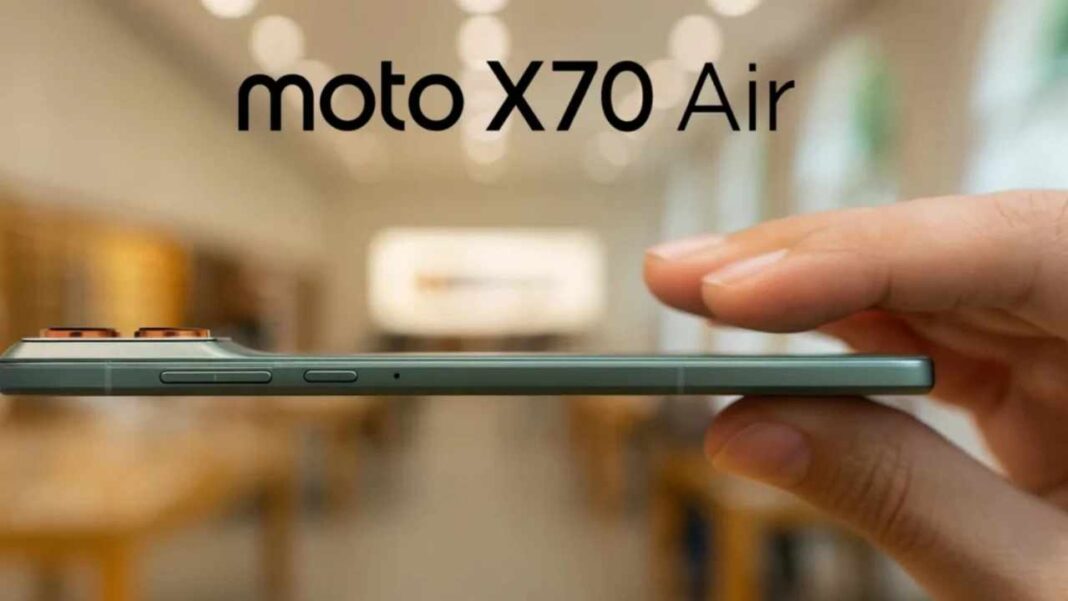Moto X70 Air: The Moto X70 Air, a fashionable and performance-focused smartphone made for consumers seeking power in a thin and light package, has been formally unveiled by Motorola. With the release of a device that directly competes with OnePlus, Samsung, and Xiaomi, Motorola is attempting to increase its market share in the mid-premium smartphone segment.
The Moto X70 Air is attracting interest due to its thin design, high-refresh-rate AMOLED screen, and Snapdragon chipset, which promises excellent performance. Let’s explore every aspect of this new smartphone that you should be aware of.
Moto X70 Air: Pricing and Availability
Motorola has maintained competitive pricing in order to draw in a large customer base. The base model of the Moto X70 Air costs about ₹34,999 in India, while the more expensive models with more RAM and storage cost up to ₹42,999. The phone comes in three eye-catching colour options: Mist Silver, Carbon Black, and Air Blue.
Flipkart, Motorola’s online store, and physical retail partners have already started selling the product. Launch promotions include free EMI plans, Motorola earbud bundles, and immediate discounts for HDFC and ICICI bank customers.
Lightweight Build and Stylish Design
Users will notice the Moto X70 Air’s incredibly lightweight design right away. It lives up to its “Air” branding at a mere 168 grams. With a 7.1mm thin profile, Motorola’s phone is among the thinnest in its class. The phone’s matte-finished aluminium frame and Gorilla Glass 5 front ensure durability despite its lightweight design.
Display: An Eye-Catching Experience
The Moto X70 Air has a 6.7-inch FHD+ AMOLED screen that refreshes at 144 Hz. This greatly improves the fluidity of gaming, video playback, and scrolling. Additionally, the panel supports HDR10+, which guarantees rich contrast and vivid colors whether you’re editing photos, playing games, or streaming Netflix.
Motorola has incorporated eye-protective features like DC dimming and TÜV Rheinland certification for less blue-light strain for users who spend a lot of time on their devices.
Performance and Hardware
The Qualcomm Snapdragon 8s Gen 3 chipset, designed for speed and efficiency, powers the Moto X70 Air. Its 256GB UFS 4.0 storage and up to 12GB LPDDR5X RAM ensure seamless multitasking and quicker app loading.
The phone’s dedicated Vapor Chamber Cooling system, which helps sustain performance during extended gaming sessions, will be especially appreciated by gamers. The Moto X70 Air offers a smooth and quick user experience when paired with Motorola’s thin software skin that is similar to stock Android.
Cameras: Versatile and AI-Powered
The Moto X70 Air is equipped with a triple-camera setup on the back:
- 50MP OIS main sensor (Sony IMX890)
- 13MP ultra-wide + macro lens
- 10MP telephoto lens with 3x optical zoom
On the front, there’s a 32MP punch-hole selfie camera with AI beautification, low-light optimization, and 4K video recording support.
Thanks to AI integration, features like “Smart Focus Tracking,” “Night Vision,” and “AI Portrait” improve photography results significantly. The phone also supports 8K video recording at 30fps, giving creators powerful tools to work with.
Charging and the Battery
The Moto X70 Air has a 4,600mAh battery despite its thin design. In just 20 minutes, Motorola’s 68W TurboPower fast charging system can charge the phone from 0% to 50%. Topping up accessories like earbuds is made convenient by the device’s support for 15W wireless charging and 5W reverse wireless charging.
Updates and Software
The Moto X70 Air comes pre-installed with Motorola’s MyUX skin on top of Android 15. With just a few Moto-only features like Moto Gestures, Peek Display, and AI-powered battery management, the user interface is still fairly similar to stock Android.
In order to keep the phone current over time, Motorola has committed to providing three years of Android updates and four years of security patches.
Connectivity and Extras
The Moto X70 Air comes with all modern connectivity features, including:
- 5G with 13 bands support
- Wi-Fi 7
- Bluetooth 5.4
- NFC
- Dual stereo speakers with Dolby Atmos
There’s also an in-display fingerprint sensor, IP68 water and dust resistance, and support for Moto Secure features, giving users extra peace of mind regarding privacy.
Competition in the Market
The Moto X70 Air enters a competitive mid-premium segment, facing rivals such as:
- OnePlus 12R – similar price range, slightly bigger battery.
- iQOO Neo 9 Pro – gaming-focused but heavier design.
- Samsung Galaxy S24 FE (expected soon) – strong ecosystem advantage.
What sets the Moto X70 Air apart is its feather-light design combined with flagship-grade performance, making it unique in its category.
Should You Buy the Moto X70 Air?
The Moto X70 Air is a great choice for those who want:
- A lightweight yet powerful smartphone.
- A smooth AMOLED display with 144Hz refresh rate.
- Clean software experience close to stock Android.
- Fast charging and wireless charging support.
However, if you prefer larger batteries (5000mAh+), or a device with deeper ecosystem support (like Samsung or Apple), you may want to explore alternatives.
The final judgment
Motorola has effectively blended speed, style, and ease of use in a package that distinguishes itself from the competition with the Moto X70 Air. It is one of the most attractive phones in the mid-premium market thanks to its incredibly light design, Snapdragon 8s Gen 3 processor, AI-powered cameras, and AMOLED display.
The Moto X70 Air is a clear choice for consumers who appreciate a powerful, thin smartphone without sacrificing functionality.

